The Cambridge History of China. Vol. 13: Republican China 1912-1949, Part 2
Подождите немного. Документ загружается.


EMERGENCE OF MODERN INSTITUTIONS 381
or poor schools? He cited the Peking Union Medical College as an
example of excellence. And could the Christian schools give up evangelism
and devote all their attention to education? Hu Shih held that you could
not serve both religion and education well.
47
In speaking out against conventional missionary education, Hu Shih
and other academics like him were troubled by what they saw as a
dangerous lack of rationality in religious propagation. In this they were
at one with the Western rationalist attack on revealed religion in the name
of science, and also with the Confucian scholastic tradition of agnosticism.
Simultaneously, however, Chinese who accepted a faith in Marxism as
a new ' science of society' joined in the patriotic anti-Christian movement
as part of the anti-imperialist effort in general. By 1924 an increase in
'anti-foreign and anti-Christian' sentiment was attributed in some
missionary circles to Sun Yat-sen and his
'
hot-bed of radical elements'
in Kwangtung.
48
Early initiatives in
science
and
research
The institutional development of modern science in all its multiplicity
worldwide made great strides during the same decades before and after
1900 that saw the onset of rapid change in China. The Chinese and
foreigners who joined in developing higher education in China thus
participated in a tremendously complex process that needs to be compared
with other areas of the world. One landmark certainly was the setting
up of the Geological Survey of China in 1916 (see below). Another was
the nascent stress on scientific learning. In December 1918 Ts'ai Yuan-p'ei
declared: 'What we call a "university" is not just a place where classes
are given on schedule resulting in the production of college graduates;
it is in reality a place for conducting research in areas of knowledge of
common interest and... thus creating new knowledge to offer to scholars
here and abroad. '
49
New knowledge, it was generally agreed, was to be achieved through
the scientific method. By the 1920s this had become a faith that viewed
the scientific outlook as an instrument for dismantling the traditional
order and opening the way for China's attainment of modern nationhood.
Young intellectuals concerned over China's lack of success in the
international world became convinced the key to the problem was science,
47
Hu
Shih, 'Chin-jih'.
"
48
During
the
Northern Expedition
of
1927 young officers told
a
Western teacher
at
Hangchow
that, once the righting was over, the Chinese would 'give attention to taking back our educational
authority*. Day, Hangcbow,
56,
59-60; cp. Lutz, Christian colleges, 22
j.
49
Shu Hsin-ch'eng (1962), 1049, Ts'ai's foreword
to
the first issue
of
the Peking University Monthly,
December 1918.
Cambridge Histories Online © Cambridge University Press, 2008
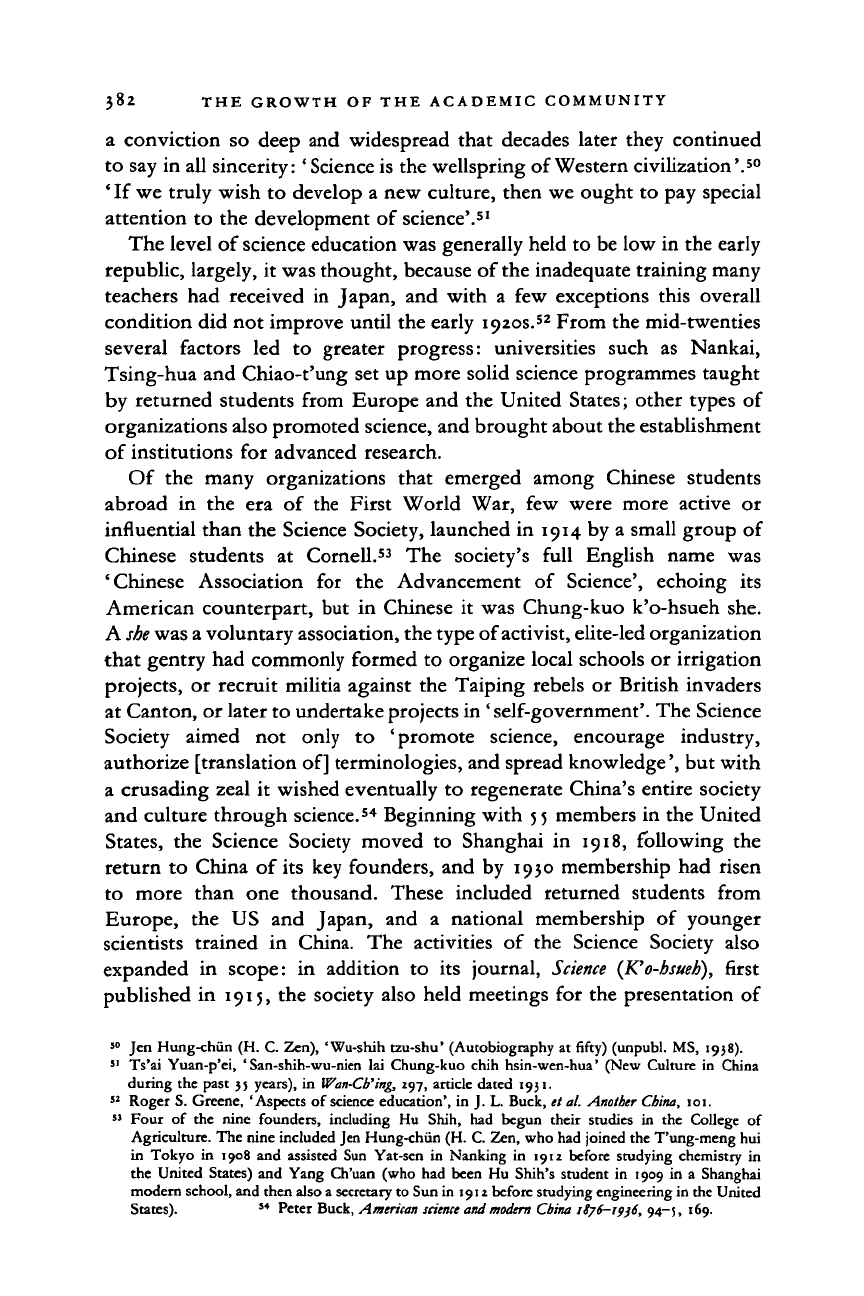
382 THE GROWTH OF THE ACADEMIC COMMUNITY
a conviction
so
deep and widespread that decades later they continued
to say in all sincerity:' Science is the wellspring of Western civilization'.
50
' If we truly wish to develop a new culture, then we ought to pay special
attention to the development
of
science'.
51
The level of science education was generally held to be low in the early
republic, largely, it was thought, because of the inadequate training many
teachers had received
in
Japan, and with
a
few exceptions this overall
condition did not improve until the early 1920s.
52
From the mid-twenties
several factors
led to
greater progress: universities such
as
Nankai,
Tsing-hua and Chiao-t'ung set up more solid science programmes taught
by returned students from Europe and the United States; other types of
organizations also promoted science, and brought about the establishment
of institutions for advanced research.
Of
the
many organizations that emerged among Chinese students
abroad
in the era of
the First World War,
few
were more active
or
influential than the Science Society, launched in 1914 by a small group of
Chinese students
at
Cornell.
53
The
society's full English name
was
'Chinese Association
for the
Advancement
of
Science', echoing
its
American counterpart, but
in
Chinese
it
was Chung-kuo k'o-hsueh she.
A
she
was a voluntary association, the type of activist, elite-led organization
that gentry had commonly formed to organize local schools or irrigation
projects,
or
recruit militia against the Taiping rebels
or
British invaders
at Canton, or later to undertake projects in 'self-government'. The Science
Society aimed
not
only
to
'promote science, encourage industry,
authorize [translation of] terminologies, and spread knowledge', but with
a crusading zeal
it
wished eventually to regenerate China's entire society
and culture through science.
54
Beginning with
5 5
members in the United
States,
the
Science Society moved
to
Shanghai
in
1918, following
the
return
to
China
of
its key founders, and by 1930 membership had risen
to more than
one
thousand. These included returned students from
Europe,
the US and
Japan,
and a
national membership
of
younger
scientists trained
in
China. The activities
of
the Science Society also
expanded
in
scope:
in
addition
to its
journal,
Science
(K'o-hsueh),
first
published
in
1915, the society also held meetings for the presentation of
50
Jen Hung-chun (H.
C
Zen), 'Wu-shih tzu-shu' (Autobiography
at
fifty) (unpubl. MS, 1938).
51
Ts'ai Yuan-p'ei, 'San-shih-wu-nien
lai
Chung-kuo chih hsin-wen-hua' (New Culture
in
China
during the past 35 years),
in
Wan-Cb'ing,
297, article dated 1931.
52
Roger S. Greene, 'Aspects
of
science education', in
J.
L. Buck, et
al.
Another
China,
101.
" Four
of the
nine founders, including
Hu
Shih,
had
begun their studies
in the
College
of
Agriculture. The nine included Jen Hung-chiin (H. C. Zen, who had joined the T'ung-meng hui
in Tokyo
in
1908 and assisted Sun Yat-sen
in
Nanking
in
1912 before studying chemistry
in
the United States) and Yang Ch'uan (who had been
Hu
Shih's student
in
1909
in a
Shanghai
modern school, and then also a secretary to Sun in 1912 before studying engineering in the United
States).
s4
Peter Buck,
American science and modern China
il/S-ifji, 94-5, 169.
Cambridge Histories Online © Cambridge University Press, 2008
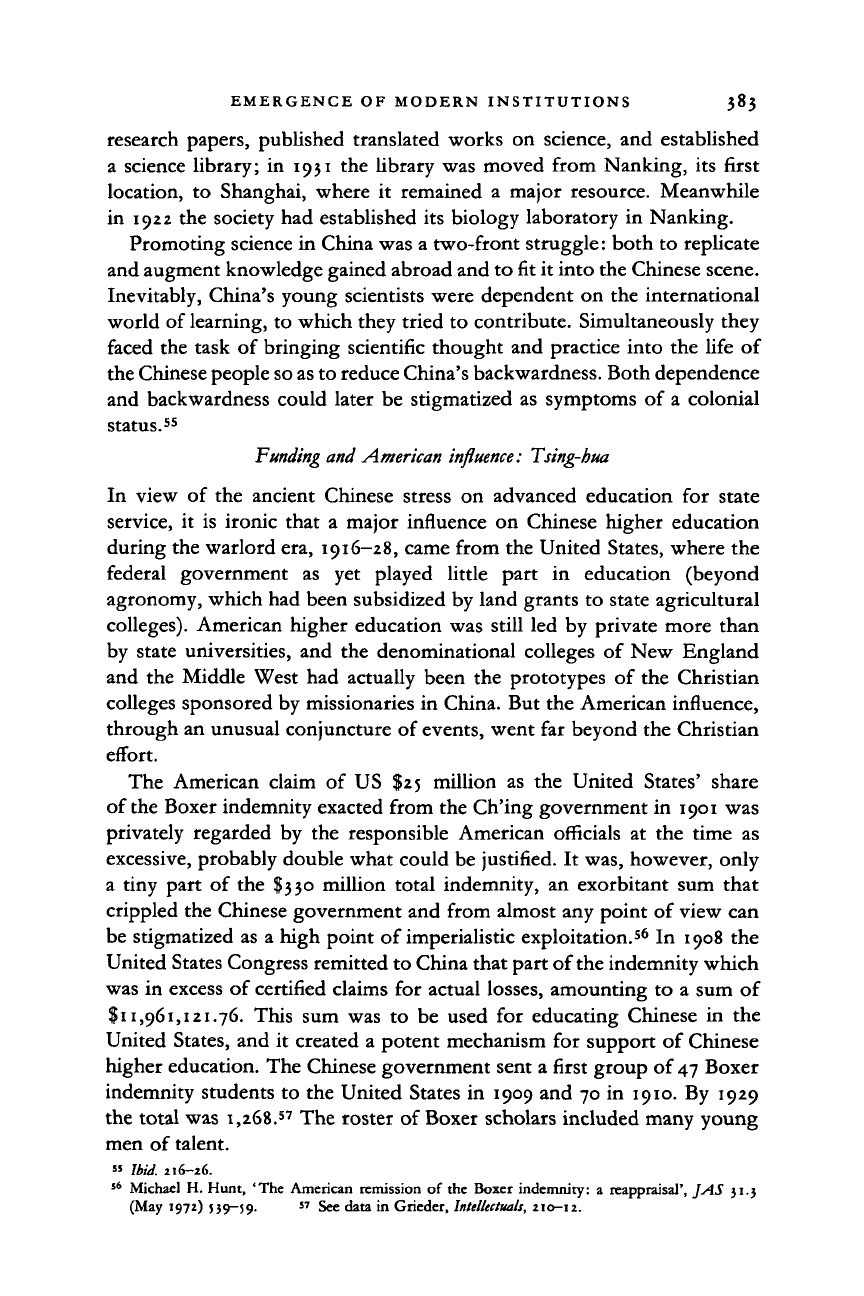
EMERGENCE OF MODERN INSTITUTIONS 383
research papers, published translated works
on
science, and established
a science library;
in
1931 the library was moved from Nanking, its first
location,
to
Shanghai, where
it
remained
a
major resource. Meanwhile
in 1922 the society had established its biology laboratory in Nanking.
Promoting science in China was a two-front struggle: both to replicate
and augment knowledge gained abroad and to
fit
it into the Chinese scene.
Inevitably, China's young scientists were dependent on the international
world of learning, to which they tried to contribute. Simultaneously they
faced the task of bringing scientific thought and practice into the life of
the Chinese people so
as
to reduce China's backwardness. Both dependence
and backwardness could later be stigmatized as symptoms
of
a colonial
status.
55
Funding and American
influence:
Tsing-hua
In view
of
the ancient Chinese stress
on
advanced education
for
state
service,
it is
ironic that
a
major influence
on
Chinese higher education
during the warlord era, 1916-28, came from the United States, where the
federal government
as yet
played little part
in
education (beyond
agronomy, which had been subsidized by land grants to state agricultural
colleges). American higher education was still led by private more than
by state universities, and the denominational colleges
of
New England
and the Middle West had actually been the prototypes
of
the Christian
colleges sponsored by missionaries in China. But the American influence,
through an unusual conjuncture of events, went far beyond the Christian
effort.
The American claim
of
US $25 million
as the
United States' share
of the Boxer indemnity exacted from the Ch'ing government in 1901 was
privately regarded
by
the responsible American officials
at
the time
as
excessive, probably double what could be justified. It was, however, only
a tiny part
of
the $330 million total indemnity,
an
exorbitant sum that
crippled the Chinese government and from almost any point of view can
be stigmatized as a high point of imperialistic exploitation.
56
In 1908 the
United States Congress remitted to China that part of the indemnity which
was in excess of certified claims for actual losses, amounting to
a
sum of
$11,961,121.76. This sum was
to be
used
for
educating Chinese
in the
United States, and
it
created a potent mechanism for support of Chinese
higher education. The Chinese government sent a first group of
47
Boxer
indemnity students to the United States in 1909 and 70 in 1910. By 1929
the total was
1,268."
The roster of Boxer scholars included many young
men of talent.
"
Ibid.
116-16.
s6
Michael H. Hunt, 'The American remission
of
the Boxer indemnity:
a
reappraisal',
JAS
31.3
(May 1972) 539-59.
"
See data in Grieder,
Intellectuals,
210-12.
Cambridge Histories Online © Cambridge University Press, 2008

384 THE GROWTH OF THE ACADEMIC COMMUNITY
Meanwhile the government also set up a training programme to prepare
young students
for
study in the United States.
In
1909
a
foreign-staffed
college preparatory school was started, entrance examinations were held
in 191 o, and what later became Tsing-hua College opened
in
1911
as
Tsing-hua School.
58
One secret of its success was that its annual budget
was assured at a time when other institutions were precariously dependent
on warlord regimes. Also, until 1929
it
stressed specific preparation
for
study
in
American universities.
A
pupil
who
passed
the
entrance
examination between eleven and thirteen years of age had to take five years
of junior division courses and three years of the senior division, after which
he or she would be sent abroad to study in an American college. The first
group, entering
in
1912, graduated
in
1920 after eight years
of
study
in
the standard modern middle-school subjects such
as
English, French,
German, history, geography, physiology, physics, chemistry, as well
as
some music, art, and physical education.
59
The preparatory-school status
of Tsing-hua came to an end in
1926,
when it was reorganized
as
Tsing-hua
College with
a
four-year programme leading to the bachelor's degree.
By that time
a
high point of American influence on Chinese education
had been reached in large part through the channels of Teachers College
at Columbia University. A number of able Chinese Ph.D. candidates had
worked with Professor John Dewey and others there. The two years that
Dewey spent lecturing in China (May 1919
-
July 1921) coincided with
the visit
of
the British mathematical philosopher and socialist Bertrand
Russell (October 1920-July 1921). Dewey gave some
70
lectures
in
eleven provinces, with
Hu
Shih translating,
but his
advocacy
of
experimentalism contained
no
political panacea
for
ardent Chinese
patriots. Later his colleague Professor Paul Monroe visited China and the
heads
of
major institutions
—
Chiang Monlin
at
Peita, Kuo Ping-wen
at
National South-eastern (later
to
be Central) University
-
counted them-
selves Dewey's disciples. Yet his typically American message of individual
fulfilment through education offered little that could be of immediate use
in
the
search
for a
Chinese way
in
education. From 1919
to
1924
an
educational reform movement was
led by
American-returned scholars,
both through major journals like New
Education (Hsin chiao-yu)
first
edited
by Chiang Monlin and through the Chinese National Association for the
Advancement
of
Education; but its plans and hopes were soon eclipsed
58
Y. C. Wang, 79, 111—14. For a comprehensive 500-page account to 1949 see Ch'ing-hua ta-hsueh
hsiao-shih pien-hsieh-tsu, comp.
CKing-bua ta-bsueb-bsiao shib-kao
(Draft history
of
Tsing-hua
University).
5» Liu Shih-shun, 'I-chiu-erh-ling chi tsai-hsiao shih-tai chih Ch'ing-hua' (Tsing-hua
in
the days
of the class
of
1920), 3—4.
Cambridge Histories Online © Cambridge University Press, 2008
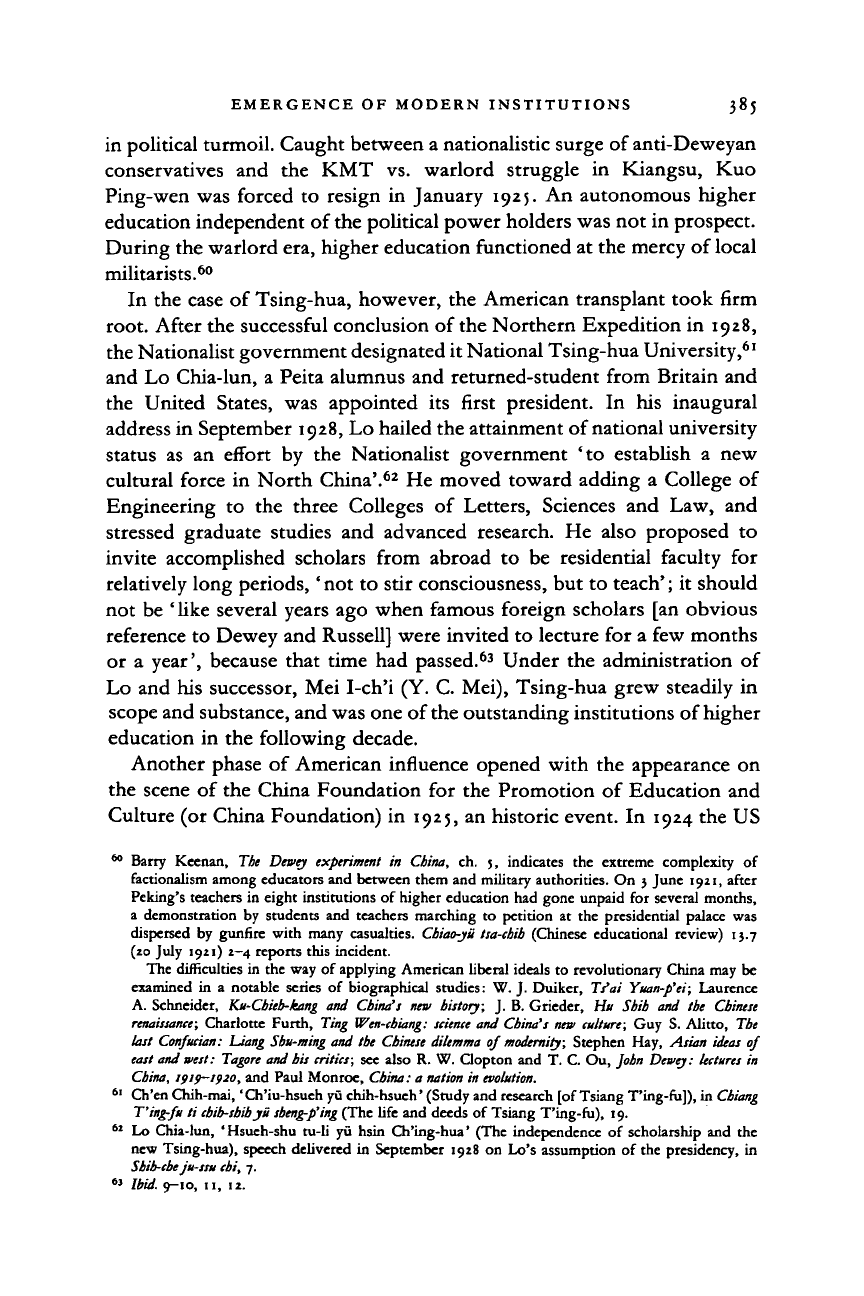
EMERGENCE OF MODERN INSTITUTIONS 385
in political turmoil. Caught between a nationalistic surge of anti-Deweyan
conservatives and the KMT vs. warlord struggle in Kiangsu, Kuo
Ping-wen was forced to resign in January 1925. An autonomous higher
education independent of the political power holders was not in prospect.
During the warlord era, higher education functioned at the mercy of local
militarists.
60
In the case of Tsing-hua, however, the American transplant took firm
root. After the successful conclusion of the Northern Expedition in 1928,
the Nationalist government designated it National Tsing-hua University,
61
and Lo Chia-lun, a Peita alumnus and returned-student from Britain and
the United States, was appointed its first president. In his inaugural
address in September 1928, Lo hailed the attainment of national university
status as an effort by the Nationalist government 'to establish a new
cultural force in North China'.
62
He moved toward adding a College of
Engineering to the three Colleges of Letters, Sciences and Law, and
stressed graduate studies and advanced research. He also proposed to
invite accomplished scholars from abroad to be residential faculty for
relatively long periods,' not to stir consciousness, but to teach'; it should
not be 'like several years ago when famous foreign scholars [an obvious
reference to Dewey and Russell] were invited to lecture for a few months
or a year', because that time had passed.
63
Under the administration of
Lo and his successor, Mei I-ch'i (Y. C. Mei), Tsing-hua grew steadily in
scope and substance, and was one of the outstanding institutions of higher
education in the following decade.
Another phase of American influence opened with the appearance on
the scene of the China Foundation for the Promotion of Education and
Culture (or China Foundation) in 1925, an historic event. In 1924 the US
60
Barry Keenan,
The
Dewey experiment
in
China,
ch. 5,
indicates
the
extreme complexity
of
factionalism among educators and between them and military authorities.
On 3
June 1921, after
Peking's teachers
in
eight institutions
of
higher education had gone unpaid
for
several months,
a demonstration
by
students
and
teachers marching
to
petition
at the
presidential palace
was
dispersed
by
gunfire with many casualties. Cbiao-yu tsa-cbib (Chinese educational review)
15.7
(20 July 1921) 2—4 reports this incident.
The difficulties
in
the way
of
applying American liberal ideals
to
revolutionary China may
be
examined
in a
notable series
of
biographical studies:
W. J.
Duiker, Ts"ai Yuan-p'ei; Laurence
A. Schneider, Ku-Cbieb-kang
and
China's
new
history;
J. B.
Grieder,
Hit
Sbib
and the
Chinese
renaissance; Charlotte Furth, Ting Wen-cbiang:
science
and
China's new culture;
Guy S.
Alitto,
The
last Confucian: Liang Sbu-ming
and
the Chinese dilemma
of
modernity; Stephen Hay, Asian ideas
of
east and west: Tagore and
bis
critics;
see
also
R. W.
Qopton
and T. C.
Ou, John Dewey: lectures
in
China, 1)19-1)20, and Paul Monroe, China:
a
nation in evolution.
61
Ch'en Chih-mai, 'Ch'iu-hsueh yfl chih-hsuch' (Study and research [of Tsiang T'ing-fu]), in Chiang
T'ing-fu
ti
cbib-sbibyS sbeng-p'ing (The life and deeds
of
Tsiang T'ing-fu),
19.
62
Lo
Chia-lun, 'Hsueh-shu tu-li
yu
hsin Ch'ing-hua' (The independence
of
scholarship
and the
new Tsing-hua), speech delivered
in
September 1928
on
Lo's assumption
of
the presidency,
in
Sbib-cbe ju-ssu cbi,
7.
63
Ibid.
9—10, 11, 12.
Cambridge Histories Online © Cambridge University Press, 2008

386 THE GROWTH OF THE ACADEMIC COMMUNITY
Congress,
by a
joint resolution, returned the remaining portion
of
the
Boxer indemnity
for use in
China.
The
understanding then reached
between
the
governments
of
the two countries
was
that
the
money,
amounting
to
approximately US $12,545,000, should be administered by
a foundation and used
for
educational and cultural purposes
in
China.
Within
a
few months the Chinese government appointed the first board
of trustees consisting of ten Chinese and five Americans, and the China
Foundation came into being
in
June 1925.
64
Of
the
ten
Chinese board
members, three were first-rank diplomats (W. W. Yen, V. K. Wellington
Koo,
and Alfred Sao-ke Sze), and the others well-known scientists and/or
names familiar
in
modern educational work: Fan Yuan-lien (Fan Ching-
sheng),
Huang Yen-p'ei
(a
leader
in
education
in
Kiangsu province),
Chiang Monlin (president
of
Peita), Chang Po-ling
(of
Nankai),
Y. T. Tsur (Chou I-ch'un, president of Tsing-hua) and Ting Wen-chiang
(of the Chinese Geological Survey). The five Americans were known for
their work
in
connection with education
in
China: John Dewey, Paul
Monroe (both of Columbia), Roger
S.
Greene (director of the Rockefeller-
funded Peking Union Medical College), John Earl Baker (of the China
International Famine Relief Commission),
and
C. R. Bennett
(of the
National City Bank).
65
The board appointed Fan Yuan-lien to be the first
director
of
the foundation, and he invited Jen Hung-chun (H. C. Zen),
an ardent advocate
of
science
in
China,
to
become
the
administrative
secretary.
66
The China Foundation was
to
administer
not
only
the
Boxer funds
returned
in
1924
but
also those returned
in
1908
as
endowment
for
scholarships
and for
Tsing-hua University.
It
was also empowered
to
handle those of Fan Memorial Institute of Biology, as well as other pro-
fessional endowments. Its major tasks were first, to subsidize institutions
in qualified activities including,
for
example, the Vocational Education
Association led by Huang Yen-p'ei; second, to support governmental and
private institutions
in
new projects
as
cooperative ventures; and third,
to launch new projects on the foundation's own initiative.
67
In the modern
64
Jen
Hung-chiin (H.
C.
Zen),
A
summary report of the activities of the China Foundation for
the
Promotion
of Education
and
Culture,
if2j—if4J,
hereafter Summary report,
1—2.
65
Ibid.
Later additions
to
the
board
of
trustees included names equally well known
in the
development
of
modern Chinese education
and
culture, among them
Y. R.
Chao,
Fu
Ssu-nien,
Hu Shih,
J.
Leighton Stuart,
T.
F. Tsiang
and
Weng Wen-hao.
66
Jen
recalled later that, ever since
his
return from
the US in
1918,
'I
had
persisted
in
bending
my fellow-countrymen's ears about
the
importance
of
science
Now
here
is
this well-endowed
organization with
an
annual budget
of
some
one
million dollars towards
the
promotion
of
scientific enterprise!...
So I
gladly accepted
...'
Jen,' Wu-shih tzu-shu', under' 192
5'.
He
became
director
of
the China foundation
in 1929.
67
Summary report,
4.
Margo
S.
Gewurtz,
'
Social reality
and
educational reform:
the
case
of
the
Chinese Vocational Education Association 1917-1927', Modern China,
4.2
(April 1978)
168.
Cambridge Histories Online © Cambridge University Press, 2008

HIGHER EDUCATION AND NATION-BUILDING 387
style all project proposals must receive approval from the board of trustees
or its special committees.
68
Fan and Jen, conscious of the innovative role
of the China Foundation, agreed that it should not operate merely as a
fund management office, but also as a strong promoter of modern
scientific scholarship.
69
Located in a former princely mansion in Peking,
the China Foundation in 1926—7 granted research subsidies to thirteen
universities and colleges, three research institutes, five cultural and
educational organizations, and one unclassified recipient, for a total of
Ch. $419,906.
70
When the foundation was taken to task for dispensing
large sums of money at the discretion of a small group of individuals
instead of through official national authorities, Jen replied that such was
precisely the China Foundation's strength: it was set up to prevent the
government from misusing these funds for fighting civil war.
71
In time,
when the educational activities in China of Japan, Britain, Canada, France,
Germany and other Western nations have been more fully studied, it may
be possible to evaluate the American influence in a broader context,
72
which will include the Rockefeller Foundation support of medical and
other sciences in China. Returned British, French and Italian Boxer funds
were used in part for educational purposes.
HIGHER EDUCATION AND NATION-BUILDING DURING THE
NANKING DECADE
All this non-governmental growth had taken place under the impetus of
the New Culture movement and in spite of the crises of the Nationalist
Revolution of the 1920s. The degree of foreign activity in funding and
advising China's new educational development was denounced by
Marxists as cultural imperialism and was inevitably a source of concern
to all patriots eager to build a fully sovereign nation. As the Nationalist
government came into being in 1928, the country experienced a rare
interlude of relative peace. Nominal peace and unity under Nanking gave
greater scope to young intellectuals who had started their careers as the
cutting edge of the New Culture and had now reached professional
maturity. Many found the Nationalist government's stand on policy
68
Personal communication from Leong-ts'ai Yip, 15 August 1981. Yip served the China Foundation
as financial secretary 1932-78, assistant treasurer 1935—78, and trustee 1962-78.
69
Jen
Hung-chun, 'Wu-shih tzu-shu, 192;'.
70
Summary report',
5.
" BDRC 2.221.
72
For example, the German biologist-philosopher Hans Driesch lectured on metaphysics in
Nanking and Peking during 1922-3 and his sponsor, Chang Chun-mai, precipitated the scholarly
polemic on' Science and philosophy of
life',
See Furth,
Ting
Wen-cbiang,
94-13 5;
Kwok,
Scientism,
155-60; and Peter Buck, 190-6.
Cambridge Histories Online © Cambridge University Press, 2008

388 THE GROWTH OF THE ACADEMIC COMMUNITY
matters largely acceptable, and from the mid-thirties
on a
process
of
cooptation was clearly
in
evidence, with academic people going into
government posts. These intellectuals maintained close contact through
the years. In all their fields of endeavour
-
be it promotion of science and
modern medicine, social reform, research on the Chinese economy,
or
developing new thought and new literature
-
they felt that the threshold
of genuine national development had now been reached at last. In their
minds the end of the warlord era might be considered a positive outcome
of a larger historical process in which they themselves, to varying extent,
had played a part.
Central
government leadership
The work
of
the Ministry
of
Education
at
Nanking has not yet been
evaluated.
It
was
of
course concerned with literacy, schools, teacher
training and
a
multitude of problems other than higher education. One
immediate aim
at
Nanking from 1928 was
to
express China's newly
ascendant nationalism and carry out
an
'educational rights recovery'
campaign, which required that all foreign-founded Christian colleges and
universities register with the Ministry of Education, and that the heads
of such schools or colleges must be Chinese nationals. One result was to
assert the state's authority against compulsory religious instruction
in
Christian colleges
-
an aim that expressed both scientific rationalism
as
in
the
liberal West and
the
jealous nationalism
of
the KMT party
dictatorship now in power. This secular challenge to the Christian colleges
was first put forward in 1925. The policy was continued and more strictly
enforced after 1927. It touched upon not only the political issue of foreign
vs.
Chinese control, but more deeply on the question of which should
dominate, secular
or
religious-evangelical values. The more perceptive
leaders among Western educators
in
China, such as those
at
Yenching
University, were able to see the practical issues involved, for
If
the
University did not register with the government, when it became possible
to do so, the door of public service would be closed to its graduates, and they
would not be permitted to teach in registered schools or colleges. There was
therefore the danger that both faculty and students would be isolated from the
educational life of the country and have no influence thereon.
73
Consequently, Yenching
was
among the
first
to comply with
the
registration
requirement, doing so in February 1927. One
of
the government rules
for Christian institutions was
the
prohibition
of
including religious
courses among required subjects, and Yenching made all
its
religious
71
Dwight W. Edwards, YencbingUniversity, 129, also 130,149-51, 1j 5. See also Philip West, Yentbing
University and Sino-Western relations, Ifi6-i}j2, ch.
3.
Cambridge Histories Online © Cambridge University Press, 2008
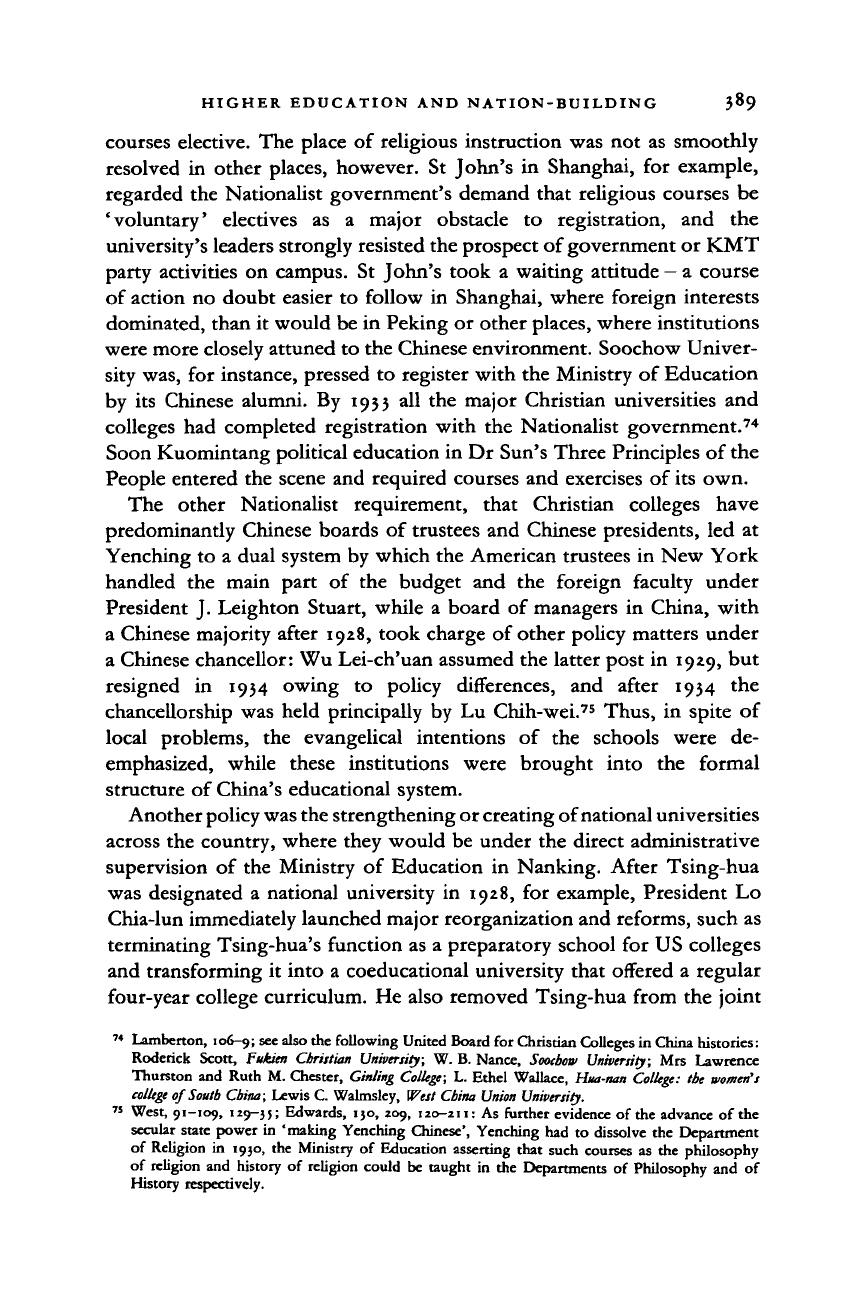
HIGHER EDUCATION AND NATION-BUILDING 389
courses elective. The place
of
religious instruction was not as smoothly
resolved
in
other places, however.
St
John's
in
Shanghai,
for
example,
regarded the Nationalist government's demand that religious courses
be
'voluntary' electives
as a
major obstacle
to
registration,
and the
university's leaders strongly resisted the prospect of government or KMT
party activities
on
campus.
St
John's took
a
waiting attitude
—
a course
of action no doubt easier
to
follow
in
Shanghai, where foreign interests
dominated, than
it
would be in Peking or other places, where institutions
were more closely attuned to the Chinese environment. Soochow Univer-
sity was, for instance, pressed
to
register with the Ministry of Education
by
its
Chinese alumni.
By
1933
all
the major Christian universities and
colleges had completed registration with the Nationalist government.
74
Soon Kuomintang political education in Dr Sun's Three Principles of the
People entered the scene and required courses and exercises of its own.
The other Nationalist requirement, that Christian colleges have
predominantly Chinese boards
of
trustees and Chinese presidents, led
at
Yenching to a dual system by which the American trustees in New York
handled
the
main part
of the
budget
and the
foreign faculty under
President
J.
Leighton Stuart, while
a
board
of
managers
in
China, with
a Chinese majority after 1928, took charge of other policy matters under
a Chinese chancellor: Wu Lei-ch'uan assumed the latter post in 1929, but
resigned
in 1934
owing
to
policy differences,
and
after
1934 the
chancellorship was held principally by Lu Chih-wei.
75
Thus,
in
spite
of
local problems,
the
evangelical intentions
of the
schools were
de-
emphasized, while these institutions were brought into
the
formal
structure of China's educational system.
Another policy
was
the strengthening or creating of national universities
across the country, where they would be under the direct administrative
supervision
of
the Ministry
of
Education
in
Nanking. After Tsing-hua
was designated
a
national university
in
1928,
for
example, President
Lo
Chia-lun immediately launched major reorganization and reforms, such as
terminating Tsing-hua's function as a preparatory school for US colleges
and transforming
it
into
a
coeducational university that offered
a
regular
four-year college curriculum. He also removed Tsing-hua from the joint
74
Lamberton, 106-9;
see
^s*
5
*e
following United Board for Christian Colleges in China histories:
Roderick Scott, Fukicn Christian University; W.
B.
Nance, Soocbow University;
Mrs
Lawrence
Thurston and Ruth M. Chester, Gin/ing College;
L.
Ethel Wallace, Hua-nan College: the women's
college
of
South
China; Lewis
C
Walmsley, West China Union University.
« West, 91-109, 129-35; Edwards, 130, 209, 120-211: As further evidence
of
the advance
of
the
secular state power in 'making Yenching Chinese', Yenching had
to
dissolve the Department
of Religion
in
1930, the Ministry
of
Education asserting that such courses
as
the philosophy
of religion and history
of
religion could be taught
in
the Departments
of
Philosophy and
of
History respectively.
Cambridge Histories Online © Cambridge University Press, 2008
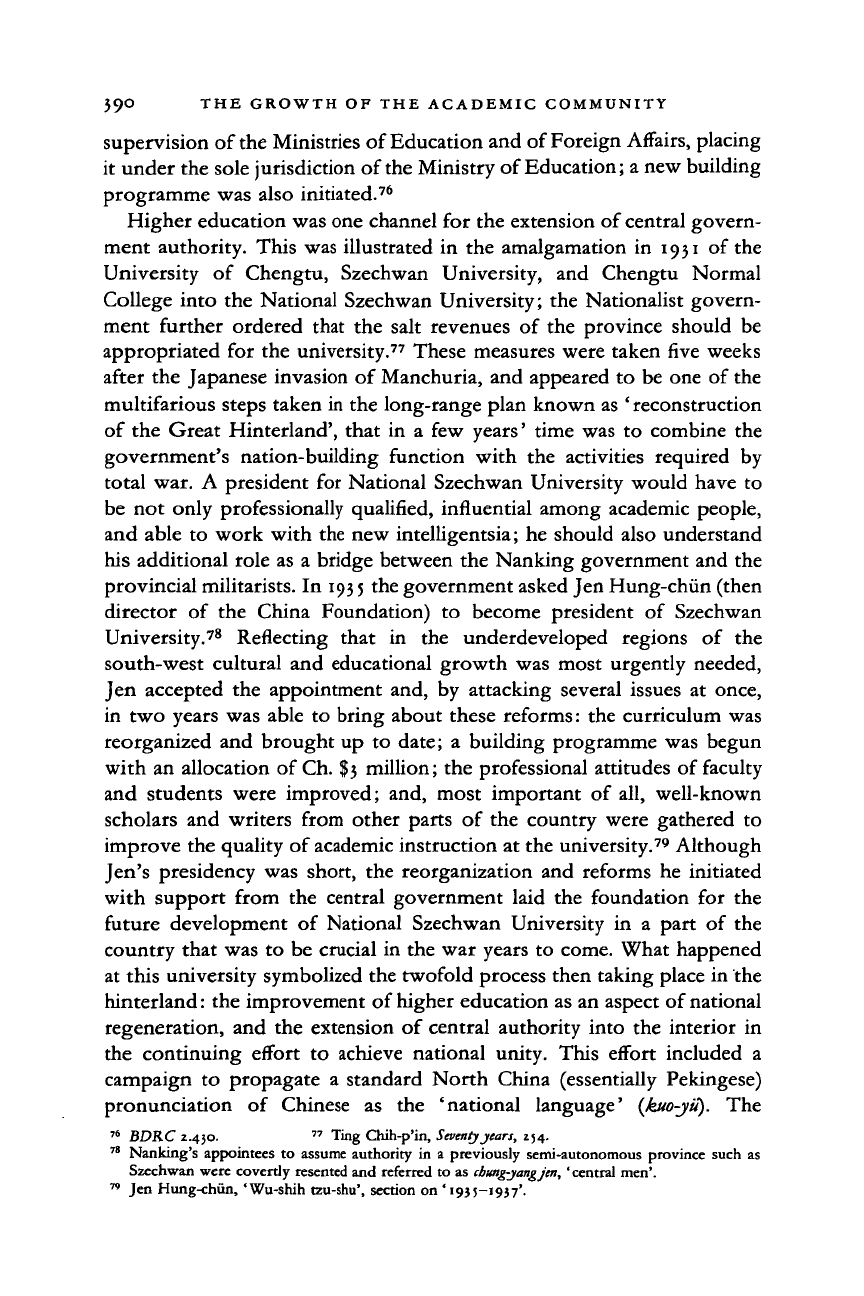
39° THE GROWTH OF THE ACADEMIC COMMUNITY
supervision of the Ministries of Education and of Foreign Affairs, placing
it under the sole jurisdiction of
the
Ministry of Education; a new building
programme was also initiated.
76
Higher education was one channel for the extension of central govern-
ment authority. This was illustrated in the amalgamation
in
1931 of the
University
of
Chengtu, Szechwan University,
and
Chengtu Normal
College into the National Szechwan University; the Nationalist govern-
ment further ordered that the salt revenues
of
the province should
be
appropriated for the university.
77
These measures were taken five weeks
after the Japanese invasion of Manchuria, and appeared to be one of the
multifarious steps taken in the long-range plan known as ' reconstruction
of the Great Hinterland', that
in a
few years' time was
to
combine the
government's nation-building function with the activities required
by
total war.
A
president for National Szechwan University would have
to
be not only professionally qualified, influential among academic people,
and able to work with the new intelligentsia; he should also understand
his additional role as
a
bridge between the Nanking government and the
provincial militarists. In
193
5
the government asked Jen Hung-chiin (then
director
of
the China Foundation)
to
become president
of
Szechwan
University.
78
Reflecting that
in the
underdeveloped regions
of the
south-west cultural and educational growth was most urgently needed,
Jen accepted the appointment and,
by
attacking several issues
at
once,
in two years was able to bring about these reforms: the curriculum was
reorganized and brought up to date;
a
building programme was begun
with an allocation of Ch. $3 million; the professional attitudes of faculty
and students were improved; and, most important
of
all, well-known
scholars and writers from other parts
of
the country were gathered
to
improve the quality of academic instruction at the university.
79
Although
Jen's presidency was short, the reorganization and reforms he initiated
with support from the central government laid the foundation
for
the
future development
of
National Szechwan University
in a
part
of
the
country that was to be crucial in the war years to come. What happened
at this university symbolized the twofold process then taking place in the
hinterland: the improvement of higher education as an aspect of national
regeneration, and the extension
of
central authority into the interior
in
the continuing effort
to
achieve national unity. This effort included
a
campaign
to
propagate
a
standard North China (essentially Pekingese)
pronunciation
of
Chinese
as the
'national language' (kuo-ju).
The
76
BDRC 2.430.
"
Ting Chih-p'in, Seventy years, 254.
78
Nanking's appointees
to
assume authority
in a
previously semi-autonomous province such
as
Szechwan were covertly resented and referred to as
cbmg-jangjen,
'central men*.
79
Jen Hung-chun, 'Wu-shih tzu-shu', section on '1935-1937'.
Cambridge Histories Online © Cambridge University Press, 2008
